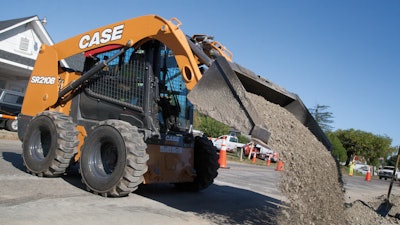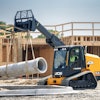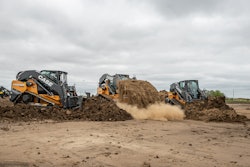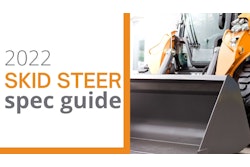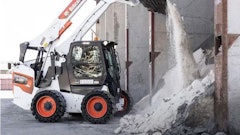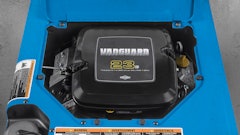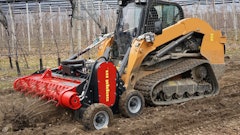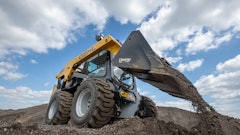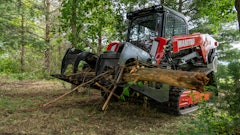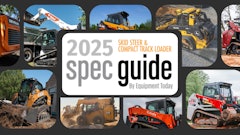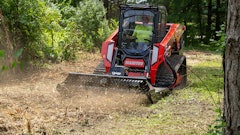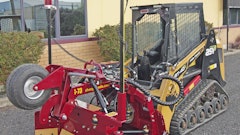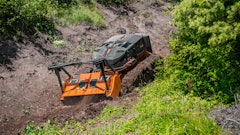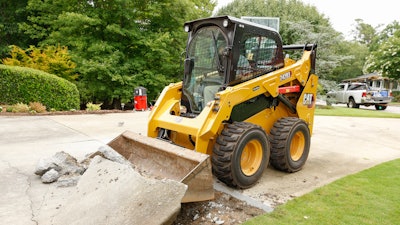
Article provided by CONEXPO-CON/AGG
If you want more uptime, lower overall operating costs, greater resale value, and a longer life for your skid steer, preventive maintenance (PM) is key. Experts from CONEXPO-CON/AGG staples Caterpillar, CASE and Wacker Neuson have all the PM tips you need for skid steers.
Make It a Habit to Check These Every Day
Operators should start each workday with a daily walkaround inspection in which they:
- Check fluid levels (hydraulic fluid, fuel, coolant, engine oil) to make sure they are in the operating range specified in the owner’s manual. “Fluid levels can have a significant effect on the machine’s performance and can lead to overheating a particular system, loss of machine performance or even downtime,” says Kevin Coleman, senior product specialist at Caterpillar.
- Check the filters (engine air filters as well as cab filters). “Owners who are diligent about following filter maintenance intervals are the ones who will see the least amount of downtime,” says Fred Paul, Wacker Neuson University manager. “By utilizing high-quality fuel, oils and OEM filters, the owner is in a position to maximize uptime and productivity.”
 Fluid sampling is an often-overlooked practice that can tell you a lot about the health and performance of your machine. It is especially important if a machine has had previous owners or has been used across numerous jobsites.Case Construction Equipment
Fluid sampling is an often-overlooked practice that can tell you a lot about the health and performance of your machine. It is especially important if a machine has had previous owners or has been used across numerous jobsites.Case Construction Equipment- Inspect the fuel and water separator bowl and drain any water and apply grease to all greasing locations.
- Check all hoses for damage or wear and confirm all safety guards/braces are present and in working order.
- Verify that the fluid compartments are sealed with the proper caps and remove any debris from the machine (engine compartment, around axles, etc.)
- Check tires for wear or damage and for proper inflation.
Tire inspection is key for skid-steer loaders. “Flat or underinflated tires can affect the machine’s safety and performance in addition to leading to downtime,” says Coleman.
“If you have a low tire when you lift a load off the ground, it can make the machine very unstable,” adds Paul.
Don't Skimp When It Comes to Fluid Sampling
Fluid management was a key topic of education at CONEXPO-CON/AGG 2020, and according to MacIntrye, fluid sampling is an often-overlooked practice that can tell you a lot about the health and performance of your machine. CASE recommends engine oil samples be sent for analysis every 250 hours, hydraulic and transmission fluid every 250 to 500 hours, and coolant be tested annually.
Owner’s manuals will include the recommended intervals for your machine.
“The important thing is to take oil samples regularly so that changes can be identified, the correct diagnosis made and remedial measures taken,” says Coleman. “Fluid sampling will also help an owner to monitor the total health of the machines.”
MacIntyre believes fluid sampling is especially important if a machine has had previous owners or has been used across numerous jobsites. “It’s often those unseen issues that can create the most unexpected downtime events,” he says.
When maintenance records provide a history of fluid sampling, it can be valuable when trading in your machine. “Fluid sampling may also allow for extended oil drain intervals for certain fluids, thereby reducing owning and operating costs,” says Coleman.
Tap Into Telematics
Without dedicated fleet managers, many small and mid-sized firms that own skid steers can find it challenging to schedule routine maintenance. Basic telematics programs provide hour readings and location data that can help these businesses stay ahead of maintenance intervals. More comprehensive telematics solutions provide additional functionality for machine monitoring, health and maintenance.
 Basic telematics programs provide hour readings and location data, while more comprehensive solutions provide additional functionality for machine monitoring, health and maintenance.Wacker Neuson
Basic telematics programs provide hour readings and location data, while more comprehensive solutions provide additional functionality for machine monitoring, health and maintenance.Wacker Neuson
While the number of skid-steer owners opting for telematics is relatively low in comparison with larger machines, MacIntyre sees an upward trend as equipment owners realize the advantages.
Get Operators on Board with Maintenance
Operators are the first line of defense when it comes to taking action on maintenance items. In addition to daily inspections, operators need to understand how to respond to in-cab alerts and messages.
Most skid steers include a machine vehicle control unit (MVCU) that provides real-time indicators of machine conditions. The codes could indicate something major, or something as simple as low DEF (diesel exhaust fluid). If addressed promptly, small problems can often prevent larger ones.
“When an operator has 'ownership' of a piece of machinery, they tend to feel more involved with the company, have more pride in their work and improved morale,” states Paul. “Owners who weave daily maintenance responsibilities into the operator’s task list will realize better functioning machinery and reduced downtime.”
Consider Options to Reduce Maintenance Burden
Manufacturers and dealers are making it more convenient than ever for fleet owners to maintain equipment.
A Cat Customer Value Agreement ensures that parts are delivered on time with instructions for maintenance. “Owners get the security of an Equipment Protection Plan (EPP) to avoid unexpected costs for unplanned repairs,” says Coleman. “All the keys to machine health management conveniently display on your phone. And it all can be rolled in with their monthly machine payment.”
Wacker Neuson Service kits can be ordered prior to a scheduled PM so parts are on hand when the service is performed, reducing any downtime associated with the maintenance.
And Cat Self-Service Options offer a broad range of common repair options, packaged with everything a customer needs to do the work themselves — in their shop or in the field.
Held every three years, CONEXPO-CON/AGG features the latest equipment, products, services and technologies for the construction industry, as well as industry-leading education. The next CONEXPO-CON/AGG will be held March 14-18, 2023 in Las Vegas, NV.
